The Digestive Process
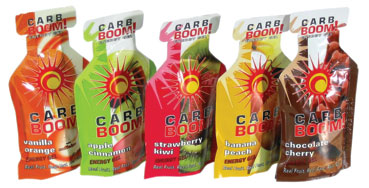
As we approach the time of year when you begin to build up mileage and or speed, the potential to suffer the dreaded bonk, knock, fringale or whatever else you want to call it increases.
It can happen to anyone, anywhere and usually in the blink of an eye. By the time you realise it's about to happen; it's too late. Even the best riders in the world have been known to succumb; ask Indurain or Contador. And it can most definitely happen to you when you least expect, or want, it.
What is this "bonk" you speak of?
Although not pleasant, the bonk is something you have to
experience at least once in your cycling career. And once you have, you'll
do everything you can to make sure it
never happens again.
When the bonk hits it feels as though someone's just flicked the power switch to off, in your body and mind. As David Duffield used to say, "the man with the hammer comes..."
It is, in essence, a rapid and complete depletion of glycogen, and as such, energy reserves. You literally feel "empty", there is nothing, absolutely nothing, left in the tank.
As you progress through your cycling career, you learn to pick up the tell-tale signs and do something about it.
It can be prevented so easily it's laughable. Just one sentence will cover it ~ Eat before you're hungry and drink before you're thirsty.
Read this factsheet to get an appreciation of what happens to your body when you eat, and how long it takes to happen. You'll then understand why the previous paragraph is so important.
6:00 pm The night Before
Check your tyres for cuts and clean out the flints. A quick
brake check for operation and pad levels, and a run through the gears lubing the chain
for good measure.
Bottles filled with powder but not water, energy bars sorted and fruit of choice (apple or banana) selected and ready to go.
Before going to bed, prepare your clothing and if it's winter, place your clean, washed gloves and socks on the radiator; you can't see Cavendish doing it but it feels nice in the morning.
Have a quick weather check, select your Oakley lens of choice for the morning, and that's it, you're ready to roll. Time for your evening meal and to fuel up on the carbs.

07:00
We've woken up and already done most of the things necessary to
prepare for our morning club ride or as we call it here, our
Gunsite Grupetto. All we need
to do now are our ablutions and fuel ourselves for the ongoing morning's activities.
No rush, no panic.
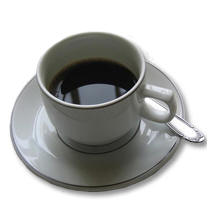
07:15
A bowl of
cereal (preferably porridge due to its low glycemic index and preferably
made with water), although I do it with half milk. I'm old and I'm
allowed.
Drop some honey in there to make it more palatable!
Then a slice or two of honey on toast and a cup of tea or coffee. Although you may pay the price for this later on as we traverse the cold, windswept, toilet-less wastelands that are usually a team training ride.
Fill the bottles with water, mix vigorously, then immediately place them on your bike. This gives you a chance to check your tyre pressures, as you don't want to find find you have a puncture as you're about to go out the door.
Cut the banana in half, and/or the apple in quarters and place the food in your pockets. All this can be done in the two minutes thirty seconds it takes to microwave a bowl of porridge.
Then it's the final emergency toilet visit, (I told you, I'm old) wash the hands, and we're ready to leave at 8:10 for the 8:30 Grupetto with plenty of time for a decent warm up and a leg stretch.
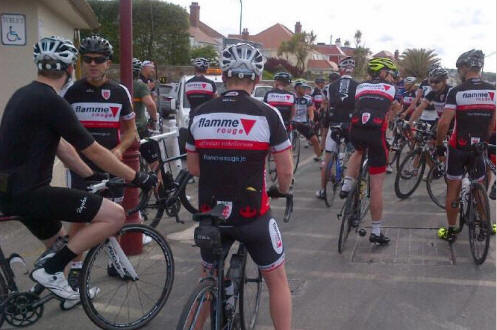
08:10 Pat the wife, kiss the dog and I'm off out for four hours of mayhem with the greatest bunch of people you could wish to meet. Arrive at 8:25 to see who's got new kit/wheels/bling, brief everyone on what's going to happen in the morning's ride and we're ready to roll...
08:30
If you belong to a traditional cycling club, everyone probably arrives a little after the official start time,
as they don't like waiting in the cold. So those that arrive early, lose their warm up as they wait for the
late comers to turn up, who are as warm as toast. They then
proceed to ride at full-gas from the off. How ironic is that?
We leave at 8:30, prompt! If you're late, you've some chasing to do! Being cold burns energy, we have precious little to waste, so at 8:30 we ride. It's the professional thing to do.
It's been more than an hour since you last ate. Before you leave, take a quick bite of energy bar, or your food of choice. The refueling process starts before the ride does!
09:30
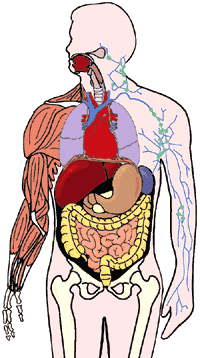 It's
an hour into the ride and,
if you haven't eaten already, your time to
do so is already running out.
It's
an hour into the ride and,
if you haven't eaten already, your time to
do so is already running out.
Your breakfast should have taken care of the first hour and is slowly being processed and metabolised as we speak.
To ensure adequate energy supplies for later in the ride, from the off, you need to sip your energy drink every ten minutes and slowly chew a small bite of energy bar, or fruit, every fifteen.
Yes, as regularly as that!
As you chew the food, your teeth mash it to a pulp and the saliva in your mouth helps turns it to a dark, mushy, gloop.
Your saliva's enzymes have already started to work on, and break down, the food's complex carbohydrates before you've even swallowed it.
09:31
Once swallowed the
food is forced down your throat by muscle
contractions that block your airways. So you don't need me to tell you
don't eat on a hill or when the chase is on. Eat, or breath
heavily, it's one or the other, not both.
Yet loads of people eat at the foot of a hill hoping the food will work quickly enough to get them up it. Sadly it doesn't work like that.
09:32
Once in the stomach, the
food stimulates the production and release
of acids, and further enzymes, to chemically break it down in to its
energy giving constituents.
The stomach produces three to four pints of fluid per day for this
process. There's an awful lot going on down there.
Your stomach enzymes are only responsible for the breakdown of fats and proteins. They can't process carbohydrates, which are ignored and shuffled further along the system for processing elsewhere.
09:33
The process of exercise requires the body to
use as many
resources that are available to it, which are not deemed necessary to maintain survival.
Obviously brain and organ function are deemed critical, so they get
first dibs on oxygen, blood, energy, etc. Everything else is
diverted to provide power for the task in hand. Or as it's now
known Strava Chasing!
Digestion, at this point, is not deemed critical to survival. So food is held in the stomach and digestion slows itself down from its normal speed until resources for digestion become available.
As you will see from the statement above; the harder you go, the less chance you have of processing the food you need to fuel your attempts to go hard. More irony!
Which is why you need to eat when the pressure is off. There's little point in eating when you're chasing or driving the break. Although it may give you a "comfort factor" it won't power the muscles.
My tip? Eat on the descents, it's the sensible and cool thing to do.

See! How cool do I look?
Caught off guard descending the Ghisallo ~ Giro Lombardia Sportive
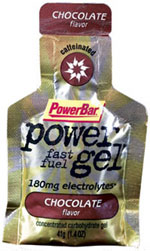 Three minutes after eating the stomach begins to flood with fluids. Each gram of carbohydrate requires three
grams of water to process it.
Three minutes after eating the stomach begins to flood with fluids. Each gram of carbohydrate requires three
grams of water to process it.
Which is why you need to drink when you take a gel, as theoretically you could begin a dehydration process.
A gel with 25 grams of carbs requires 75 grams of fluid to enable processing. It has to come from somewhere.
Water is now heading to your stomach from around the body. Which may cause dehydration and possible cramps if you haven't previously drunk enough fluids during your ride.
When the digestion process begins, the stomach goes into mild contractions to mix thoroughly it's gloopy, acidy, fluidy contents.
09:39
By now the contents of the stomach are thoroughly mixed and will
soon begin to separate out. Fats rise to the top and carbs sink to the
bottom. The bottom of your stomach that is!
09:55
Twenty five minutes
in and the mush has now almost been turned in to a thick liquid. Yet even in this
state it will not be ready for processing for a further fifteen minutes.
It's now possible to see the importance of energy drinks. They bypass the early phases of munching and mixing and release their nutrients almost immediately on consumption.
Energy drinks (at 6% concentration) moved on to the small intestine nearly twenty minutes ago. So drink little and often to keep one step ahead of the game.
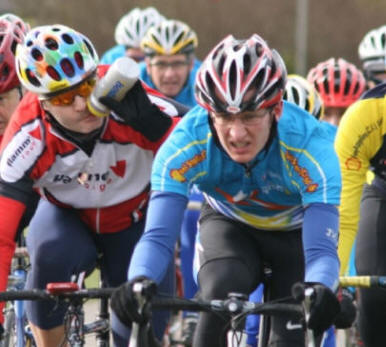
10:10
Assuming your body
started with full stomach, liver and muscle glycogen saturation, you
can ride for around 90 minutes before levels reach a critical point.
If you didn't start "saturated" then the danger zone arrives much
sooner, and probably more savagely, than you would like or realise.
If you haven't eaten at all, you are now well into the "bonk zone". Which isn't half as exciting as it sounds. Your ride could well become very interesting, very soon. And not in a good way.
For those that have eaten; the stomach, miraculously just in time, opens the door to its processed riches. Slowly passing its energy giving contents to the duodenum.
The pancreas, in a fit of altruism, adds its enzymes to allow the beginning of digestion of the carbs and the completion of the stomach's partly completed protein metabolism.
While the gall bladder, not to be left out, throws in some bile, to help digest the previously partly processed, fat residue.
It's been forty minutes since you first ate and only now are things beginning to happen.
10:13
Now released from the
stomach, carbohydrates are beginning to be broken down in to glucose and absorbed
in to the blood for onward transportation to the liver.
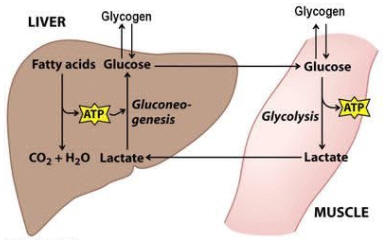
The proteins are beginning to revert to their form of amino acids, and the fat begins its dissolvation in to fatty acids.
At last, the body's absorption of these disparate nutrients can now begin.
10:16
The energy containing mush is
now on its way to the small intestine.
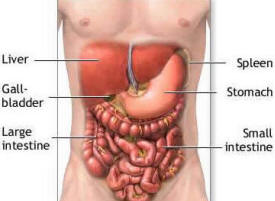 The first third of
the small intestine concentrates on absorbing glucose for the liver.
The first third of
the small intestine concentrates on absorbing glucose for the liver.
Once the glucose reaches the liver it is used to manufacture the much needed glycogen.
The glycogen is stored in the liver itself and when needed transported to the muscles for immediate use or further storage.
Amino acids, fatty acids, vitamins and minerals go straight from the small intestine to the bloodstream.
11:00
The remnants of our
food are still in the small intestine,
although most of its energy resources have now been extracted and
processed.
11:30
The ride is almost over
and almost all of our food has been eaten. For the food that has
been eaten, the glucose from the carbs has
been absorbed and most of the proteins partially processed. Fat
digestion and absorption has hardly begun.
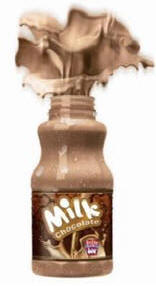
12:30
The "ride" is over and
we're heading home on the cool down. If you've any food, or
drink, left at this point, consume it. Your recovery starts
now!
Once the effort backs off, you need to do all sorts of things to help your recovery, but here, we're just interested in the digestion side.
As soon as you stop "training" the "glycogen window of opportunity" becomes fully open.
Recovery protein either in a drink, or solid food form are your first requirements.
After you've showered and checked your SRM/Strava files (not necessarily in that order) you need to be thinking about a carb rich meal.
The energy bar and food consumed on your ride is still being processed.
The protein de-constructed amino acids are just reaching the liver where they recombine to form plasma proteins and enter the blood stream. The excess protein is metabolised for energy (a little too late) or turned to fat and stored for later use.
3:30
The remains of the
food eaten early in the ride now leave the small intestine and head for
the large intestine.
 Almost 90% of its nutrients have been stripped and
the residue is on its way to its natural conclusion.
Almost 90% of its nutrients have been stripped and
the residue is on its way to its natural conclusion.
The large intestine reclaims the fluid used to aid digestion and returns it to whence it came.
What remains will reappear and be flushed away in the fullness of time.
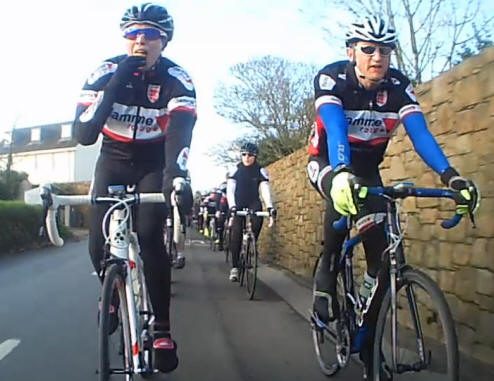
The Message
Eat early, eat little and eat often if you want to have a successful
ride; and don't forget to drink.
Eat before you are hungry and drink before you are thirsty, or it's too late.
Your body can ride for around 90 minutes before its tanks start to run dry and it takes nearly 30 minutes to process what you've eaten.
If you haven't eaten within the first hour you could be facing a long, slow, lonely ride home. If you were to drive your car for four hours, you'd make sure there was fuel in the tank and you'd keep an eye on the fuel gauge during the journey. Riding your bike is no different.
Have fun...








